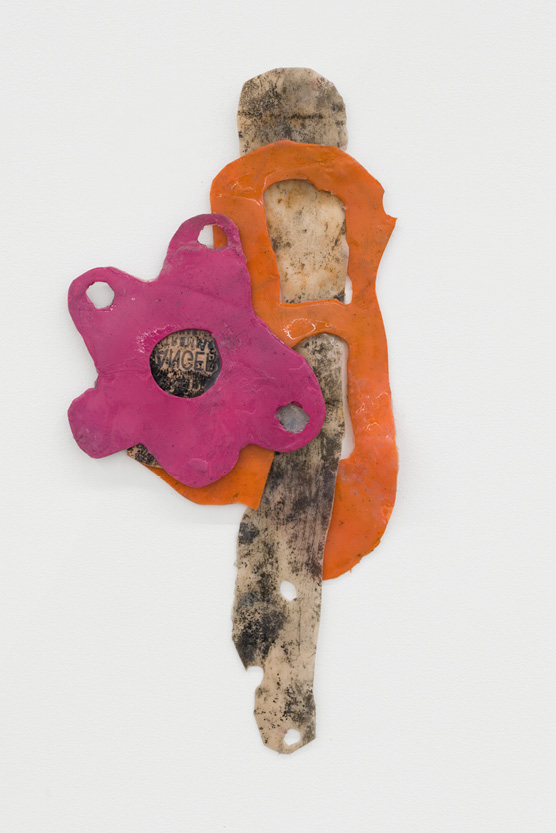Sara Gernsbacher’s wall works are not paintings. They are compositions of simple colors and shapes that suggest, rather than indicate, juxtapositions, combinations, interconnections, meldings and separations.
Spray painted, trimmed and further layered, they evoke a multidimensional presence.
They are often semi-figurative. And they are tactile, mostly wrought of acrylic and enamel on poured, colored silicon sheets. Yes, you can touch them. If you dare.
There are seven of them on display at the Parrasch Heijnen Gallery. They surround you in a single room. If they—for the most part—share a single motif, it is that of a flat-figured floral shape, much recalling Andy Warhol’s famous, brightly colored five-petaled hibiscus shapes of the mid-’60s.
But Warhol’s blooms were flatly displayed in orderly rows in regular, rectangular formats. Gernsbacher’s blooms, however, challenge the flowers’ passive, decorative, feminine role. They have been sullied, dirtied, besmirched, pierced or entwined by the other colored shapes in the work. They have all led a rough tough life. In Ronald Firbank’s phrase, they are “The Flower Beneath the Foot.’’ Yet, each blossom shape also finds its place as a highly stressed component in Gernsbacher’s work.

Sara Gernsbacher, Flower Brick Body – Black Center Yellow Out (2018), courtesy Parrasch Heijnen Gallery.
Take her creation Shape is Your Touch (all works 2018). An orange figure-eight body seems to be holding a magenta blossom as a shield, while it takes a step. Is it receding or advancing? Aggression or retreat? The beholder decides.
Three into One is the most multi-dimensional of Gernsbacher’s pieces here (it juts out of the wall nearly five inches). Three feet tall, its two leg-like components join at the cowled top at a narrow angle. Its colors are dull and muted, but its cloaked torso and hooded facial vacancy mournfully address the onlooker.
In its jointed scalene triangularity, Magic Child is like a more affirmative cousin to Three Into One, but here, the yellow “blossom” is more of an ornament than an implement of battle. It circles the right segment of the construction like a bright cuff, giving the flesh-tinted element a dancerly pose and the work itself a sense of latent movement.
Flower Brick Body, on the other hand, is a four-eyed, jump-up delight, evoking SpongeBob SquarePants. Combined of four of Gernsbacher’s trademark papery-looking blossoms, it clings to the gallery wall like a large, bright-yellow moth. You almost expect it to flutter. Again, the sense of impending motion.
Most pleasing to me of all was Up Arms Center, a being consisting of a black, squat torso with four extended pink-colored limbs. The two “arms” grasp a yellow Gernsbacher blossom overhead, as though it were an oversize golden ball. For all the world, it seems like the figure is trying to sink a basket.
Maybe that is one of the subtler delights of Gernsbacher—her dry, invasive humor that infects her most colorful works and animates their sense of imminent motion, as though they might spring to life before our eyes. Meanwhile, they fire our imagination.


